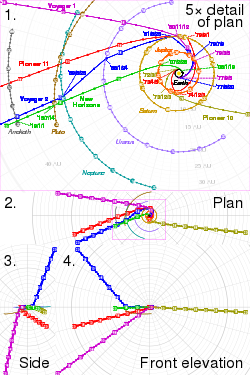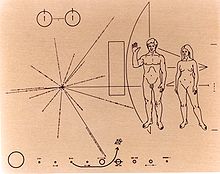Pioneer 11
[3] A backup unit, Pioneer H, is currently on display in the "Milestones of Flight" exhibit at the National Air and Space Museum in Washington, D.C.[4] Many elements of the mission proved to be critical in the planning of the Voyager program.
If there were faint ring particles capable of damaging a probe in that area, mission planners felt it was better to learn about it via Pioneer.
The object was tentatively identified as Epimetheus, a moon discovered the previous day from Pioneer's imaging, and suspected from earlier observations by Earth-based telescopes.
After the Voyager flybys, it became known that there are two similarly sized moons (Epimetheus and Janus) in the same orbit, so there is some uncertainty about which one was the object of Pioneer's near-miss.
[30] On September 29, 1995, NASA's Ames Research Center, responsible for managing the project, issued a press release that began, "After nearly 22 years of exploration out to the farthest reaches of the Solar System, one of the most durable and productive space missions in history will come to a close."
It indicated NASA would use its Deep Space Network antennas to listen "once or twice a month" for the spacecraft's signal, until "some time in late 1996" when "its transmitter will fall silent altogether."
NASA Administrator Daniel Goldin characterized Pioneer 11 as "the little spacecraft that could, a venerable explorer that has taught us a great deal about the Solar System and, in the end, about our own innate drive to learn.
[30] Scientists received a few minutes of good engineering data on November 24, 1995, but then lost final contact once Earth moved out of view of the spacecraft's antenna.
[35][36] The spacecraft is heading in the direction of the constellation Scutum near the current position (June 2024) RA 18h 54m dec -8° 46' (J2000.0), close to Messier 26.
[39] Analysis of the radio tracking data from the Pioneer 10 and 11 spacecraft at distances between 20 and 70 AU from the Sun had consistently indicated the presence of a small but anomalous Doppler frequency drift.
The plaques feature the nude figures of a human male and female along with several symbols that are designed to provide information about the origin of the spacecraft.
[43] In 1991, Pioneer 11 was honored on one of 10 United States Postage Service stamps commemorating uncrewed spacecraft exploring each of the then nine planets and the Moon.




Plot 1 is viewed from the north ecliptic pole , to scale.
Plots 2 to 4 are third-angle projections at 20% scale.
In the SVG file, hover over a trajectory or orbit to highlight it and its associated launches and flybys.

